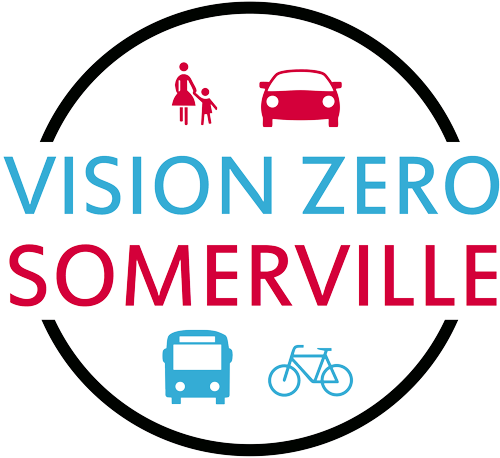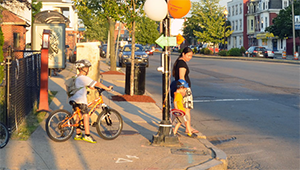
"To build a better city for generations to come, we must prioritize creating safe, accessible streets for all users in Somerville. With forward-thinking policies, design, and education, we can work together to save lives.” – Mayor Ballantyne
What is Vision Zero?
Vision Zero Somerville is the basis for the City’s commitment to street safety regardless of how you travel. The initiative works across multiple departments and uses a data-driven approach to plan, design, and install safety improvements for all people, whether on bicycles or on foot, in vehicles, or aboard public transit. Somerville is one of approximately 40 other Vision Zero communities across the country.
- A Vision Zero city must meet the following minimum standards:
- Set a clear goal of eliminating traffic fatalities and severe injuries
- Have a Mayor that has publicly, officially committed to Vision Zero
- Have a Vision Zero plan or strategy in place, or a Mayor that has committed to doing so in clear time frame
- Engage key city departments (including Police, Transportation, and Public Health).
Contact Information
Monday - Wednesday
8:30 a.m. - 4:30 p.m.
Thursday
8:30 a.m. - 7:30 p.m.
Friday
8:30 a.m. - 12:30 p.m.
Employee Directory
Jump To:
Annual Key Performance Indicators
Every winter, the Mobility Division publishes an annual progress report on our key performance indicators. We dig into trends for transit ridership, pedestrian, bike, and motor vehicle traffic, collected speed data, Bluebikes ridership, and reported crash data. We also report on key safety deliverables such as traffic calming installations and newly constructed safety and comfort improvements.
Preparing key performance indicators helps us learn more about how our transportation environment is changing and transforming, see if we met key safety goals, and evaluate our success to prepare for the next year. Below is a list of past key performance indicators presentations.
- 2024 Key Performance Indicators
- 2023 Key Performance Indicators
- 2022 Key Performance Indicators
- 2020 Key Performance Indicators
Safe Street Ordinance Reporting
In 2024, the City Council, with the support of Mayor Ballantyne, passed the Safe Street Ordinance. The Safe Streets Ordinance furthers the City’s efforts to accelerate street safety and accessibility improvements by reaffirming Somerville’s Complete Streets approach to street improvement projects, formally incorporating the goals of the City’s Bicycle Network Plan into street design processes and ensuring work to increase accessibility in the City. The ordinance also includes an annual reporting process to document progress toward Vision Zero, accessibility, and Bicycle Network Plan goals.
- In February 2025, the City published the first Safe Streets Ordinance report which includes reporting on:
- Separated bicycle facilities installed in the previous year’s construction season.
- Separated bicycle facilities planned for installation in the current construction season including forecasted expenditure for installing these facilities.
- Multi-year planning for constructing the full Priority Network by the end of 2030.
- And Pedestrian and transit infrastructure detailed in the Vision Zero Action Plan and ADA Title II Transition Plan.
Please check out the City of Somerville’s February 2025 Report to the City Council on the Safe Streets Ordinance.
Traffic Calming Map
The Mobility Division annually updates the citywide Traffic Calming Map where we show recently installed traffic calming installations and planned installations for the next few years. Check out this Citywide map of mobility and safety improvement projects to learn more about upcoming speed hump installations and crosswalk improvements.
Somerville Crash Data Dashboard
Check out our interactive map below showing crash data from 2017 to 2022. Points show the different types of crashes and were they occurred:
Early Reporting and Data
In the first couple of years of the City’s 5-Year Vision Zero Action Plan (2021) the City prepared a variety of reporting materials and additional communications materials. Please check out these resources below.
- Citywide Vision Zero Mailer: As part of our outreach, education, and advocacy around Vision Zero, the City sent out this mailer to all residents in March 2022.
- Action tracking spreadsheet: This spreadsheet shows the status of all Vision Zero actions as of the end of Year 2 (2021) of the plan.
- 2021 Vision Zero Report Card: The Vision Zero Report Card summarizes the City’s progress and accomplishments in each Vision Zero Objective Area at the end of the 2021 reporting year.
- Action Tracking spreadsheet of 0 - 2 year actions: This spreadsheet shows the status of all Vision Zero actions as of the end of year 1 (2020) of the plan.
Additionally, throughout 2020 and 2021, the City expanded 20 mph safety zones to cover most residential streets in addition to higher vulnerability pedestrian areas around schools, senior centers, medical facilities, parks, and more.
Want to learn more about traffic calming initiatives in Somerville? You can view our traffic calming map here.
In 2023, more than 40,000 people were killed across the United States in traffic crashes and many more were injured. In Somerville alone, there were 646 crashes reported in 2023, including 11 severe injury crashes, but no fatalities. These tragic results have for too long been considered an inevitability of modern mobility, and the commonplace reference to traffic crashes as “accidents” further entrenches the idea that there is nothing we can do to prevent them from happening.
Vision Zero fundamentally shifts how we approach traffic safety. Rather than assuming an acceptable level of risk from traffic crashes, it declares that no death or serious injury on our streets is acceptable and that we can proactively prevent traffic crashes through:
- Prioritizing proven safety strategies
- Interdepartmental city collaboration
- Data-driven decision-making
- A systems-based approach to traffic safety
A Vision Zero approach recognizes that people will sometimes make mistakes and that crashes will continue to occur, so it focuses on designing our streets and transportation policies so that these mistakes do not result in serious injury or death. This is one of the reasons that Vision Zero focuses heavily on speed management – to lessen the severity of crashes. The graphic below shows how much slower speeds can reduce the probability of a crash resulting in a fatality.

Vision Zero Action Plan: What does it do?
The Vision Zero Action Plan is the City’s strategy for eliminating deaths and serious injuries from our transportation system and details the actions the City will take over the next five years. It was developed by a team of City staff and dedicated resident volunteers on the Vision Zero Task Force, including representatives from advisory and advocacy committees from Somerville and the Greater Boston region. The objectives, strategies, and actions set forth are intended to be ambitious, specific, actionable, and measurable.
You can read the Vision Zero Action Plan here:
https://www.somervillema.gov/sites/default/files/vision-zero-action-plan.pdf
You can contribute to Vision Zero in a number of ways. Start by reading through the Action Plan and sign up for the Mobility Division’s monthly newsletter to stay up to date. And of course, report a concern if you see something that needs action!
You can direct any questions to the Mobility Division at Transportation@somervillema.gov.
Additional Resources & Meetings
Resources:
- City of Somerville Ordinance to Safeguard Vulnerable Road Users
- Information on the City’s 2021/22 sidewalk snow clearing pilot
- The Pavement and Sidewalk Management Program
- Somerville Police Department Traffic Citation Data Dashboard
Research Archive:
- Intersection Data
Meetings:
- January 30, 2020: Vision Zero Open House
- January 21, 2020: Vision Zero Open House
- April 24, 2019: Community Meeting on Safe Streets (Vision Zero)
- April 3, 2019. Public Hearing: Traffic Calming and Vision Zero Presentation
- December 4, 2018: Low-Cost Traffic Calming Lecture Video
- October 9, 2018: Vision Zero Task Force Presentation
- September 6, 2017: Mayor Curtatone’s Vision Zero Presentation
Feedback
Please submit website feedback using this form. Be sure to include:
Thank you for your feedback!
